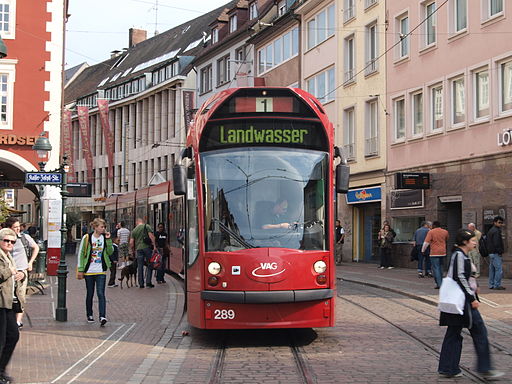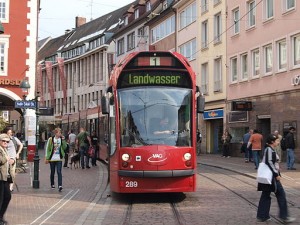
America, Germany, and the Race to Reduce CO2 Emissions
On October 12, the American Institute for Contemporary German Studies (AICGS) hosted a luncheon to present Ralph Buehler’s recent paper entitled “Daily Travel and CO2 Emissions from Passenger Transport: A Comparison of Germany and the United States”. Dr. Buehler is a resident fellow of AICGS and an Assistant Professor of Urban Affairs and Planning at the Metropolitan Institute of Virginia Tech. His paper and data revealed that the United States is miles behind Germany in sustainable transport.
To start, annual per-capita CO2 emissions from ground passenger transportation in the United States were three times greater than in Germany from 1990 to 2010. By 2010, Germany had reduced its CO2 emissions per capita in the transport sector by 17% below its 1990 levels. Meanwhile, the US only reduced its per capita CO2 emissions in the transport sector by 9%, all of which occurred between 2005 and 2010. In fact, America’s overall emissions increased by 10.4% from 1990 to 2010.
Germany and the United States share much in common, including: western style demo cracies, market economies, large federal systems of government, huge percentages of licensed drivers (nearly 70%), and historically important automobile industries; however, the nations differ drastically in regards to their CO2 reduction policies.
cracies, market economies, large federal systems of government, huge percentages of licensed drivers (nearly 70%), and historically important automobile industries; however, the nations differ drastically in regards to their CO2 reduction policies.
To briefly summarize these differences, Germany has national plan to reduce greenhouse gases (GHGs) from transport. It has strived since the Kyoto Protocol to reduce its CO2 emissions by 40% (from its 1990 baseline) by 2020. The United States lacks an explicit federal policy to reduce GHGs and state reduction plans vary greatly in efficacy and scope. Although Germany does not have mandatory fuel efficiency standards, it maintains higher fuel efficiency due to its large taxes on fuel and its transport policies. The United States recently updated its standards and has seen a great leap in efficiency since 2005, but its goals appear meek when compared to the EU’s audacious targets. In his work, Dr. Buehler highlighted three main, interrelated areas that affect CO2 emissions from ground transport: travel behavior, incentives and disincentives, and public transportation.
To begin, travel behavior is shockingly different between the two countries. Americans drive almost twice as much as Germans do per year (13,500 miles vs. 6,800 miles of passenger car travel). Cars also account for a much higher share of daily trips in America than in Germany (86% compared to 56%). Critics may point to greater distances in the U.S. as the main culprit in longer driving distances. However, when comparing trips of comparable distances, such as trips less than one mile, Americans drive 65% of the time compared to Germany’s 28%. As the data shows, Americans are simply more likely to drive than Germans, regardless of the distance. While some say that this can be attributed to a stronger “driving culture” in the United States, much of the difference is a product of policy.
Examining incentives and disincentives, both Germany and the United States provide incentives for buyers to purchase higher fuel efficiency vehicles. However, Germany provides much better tax breaks and discounts and it reinforces these incentives using a high gasoline tax (roughly more than 8 times higher than the tax in America). Germany has also reduced the availability of parking within its cities and increased the cost of car parking. Comparatively, America subsidizes about 95% of commuter automobile trips with free parking.
In regards to public transportation, the United States has a clear disadvantage. Our public transportation systems are limited, out of date, and, often times, unreliable. America’s low population density also plays a role, however, proper city planning can make public transportation efficient (see Portland’s Urban Growth Boundary). Germans make 6.5 times as many public transportation trips per year than Americans. America subsidizes 65% of its public transportation while Germany only needs to subsidize 25% of its system. The federal and regional governments in Germany have worked hard to make public transportation a more attractive option, through multi-modal coordination with other modes of transport, steeply discounted monthly and annual tickets, real time information at transit stations, and region-wide fare integration.
To reduce CO2 emissions in America from ground travel, Dr. Buehler suggests that America must reduce its subsidies for driving, increase its cost, make public transportation a more attractive option, and create a proper long term plan for walking, cycling, and public transportation. All of these efforts have to be regionally and federally supported to be effective. These policies and reforms will take time, but the end result is worth it; both for our climate and our country.






[…] America, Germany, and the Race to Reduce CO2 Emissions […]
[…] why emissions are lower lately. Report: Can U.S. Carbon Emissions Keep Falling? | Climate Central America, Germany, and the Race to Reduce CO2 Emissions Also in the US it isn't just the federal government that matters. A lot of cities are […]